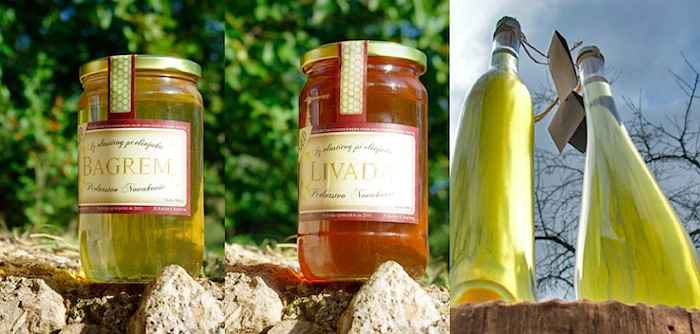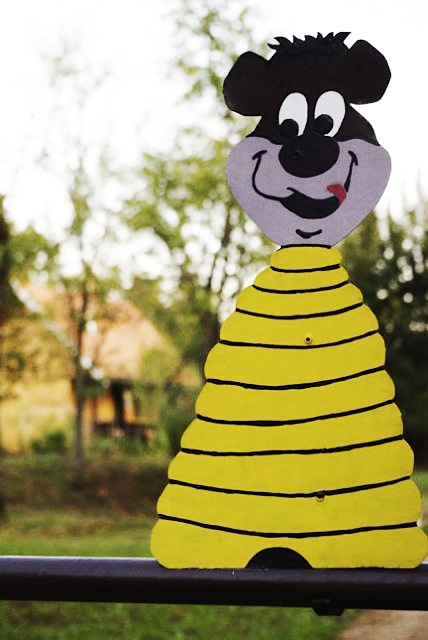“What happens to honey bees in the winter?“
“They get into a big huddle.“ Tamara Novaković replies, smiling. Her father, Rajko, driven by his love for nature (and honey), started the family beekeeping farm in 1985. The Novaković Beekeeping Farm is in the countryside of Croatia, about 10 miles from their home in Karlovac.
She continues, “During winter, bees stop flying and stay inside their hive in what is called a winter cluster. The colder the temperature, the more compact the cluster becomes.“
She continues, “During winter, bees stop flying and stay inside their hive in what is called a winter cluster. The colder the temperature, the more compact the cluster becomes.“
“In their hive, under the snow? What are they eating in there?“
“Honey.“ Tamara states matter of factly. “They feed on honey they have stored inside their hive.“
Throughout the summer, each colony sends out tens of thousands of female worker bees to gather flower nectar. The nectar will be partially digested in the bees' stomachs - the enzymes processing the nectar into honey - which is then regurgitated into the cells of the honeycomb. Other worker bees will use their wings to evaporate the watery honey, raising the sugar concentration to prevent fermentation. Finally, they will create a layer of beeswax to seal the honey inside the comb for consuming later, much of it during winter when they are unable to find nectar and pollen to feed on.
Tamara explains, “Bees are incredibly organized creatures with an amazing hierarchy. Some of the bees in the winter cluster are standing right on top of the honey. But most aren't. When a bee far from the honey is hungry she 'begs' the bee next to her for food, who then passes that message along. The bee on the honey eventually gets the message, sucks some up and passes it to the next bee...until everybody has had lunch.“
“The bees must produce a lot of honey to last them until spring?“
Tamara nods. “Yes, but sometimes they do run out, so you'll need to feed them. You can provide frames of honey from other colonies that have done well to help out the weaker ones. If you don't have enough honey, you can make sugar syrup - two parts sugar with one part water. You’ll get a nice, thick slurry, and the bees will have no difficulty turning it into winter food. However, honey is by far the best solution. Responsible and smart beekeeping will provide your bees with enough honey throughout winter.“
“And enough honey for your family throughout the winter too?“
“Yes, there was never a time - no matter what season - when we didn't have honey in our house. We use it on a daily basis - in cakes, in drinks, and as a sweetener. My parents even drink coffee with honey instead of sugar.“


Because of responsible and smart beekeeping, the Novaković Farm now has over 100 beehives producing organic honey. It is one of many beefarms around the country supplying the spice of Croatia. “We have a fair amount of different honey types in Croatia. Most common are acacia, chestnut, meadow plants, lavender, sage, linden, heather, sunflower, oak honeydew and fir honeydew.“
The flavor, aroma, texture, and color of the honey produced in a hive is ultimately based on the source of nectar available to the bees. If a beehive is placed in an area where flowering chestnut trees are most prevalent, the resulting chestnut honey will be a dark color with a rich, slightly bitter flavor.
“What type of honey is your favorite?"
“I mostly use acacia honey, because it has the mildest flavor," Tamara says.
“Is that the honey you use to bake desserts on Bite My Cake?"
“Yes, especially during winter time. One of the famous Croatian cookies are honey gingerbread cookies (medenjaci), which we bake for Christmas. Honey is great because it retains moisture, and gives your baked goods a golden crust color and a lovely flavor.“
“Is it as easy as just taking out the sugar in a recipe and replacing it with honey?“
“Not that easy. There are a few things to keep in mind when baking with honey:
- When substituting honey in recipes calling for 1 cup or more of sugar, reduce the other liquids in the recipe by 1/4 cup for every 1 cup of honey .
- In cookie recipes using eggs or recipes with no other liquids, increase the flour by 2 tablespoons for each cup of honey.
- Keep in mind that honey is sweeter than sugar.
- Oil or spray the measuring cup to make it easy for the honey to slide out after measuring.“
“Why so much honey in the Croatian diet?“
“Honey is one of the most healthy, natural ingredients. It contains around 200 different elements – including many proteins, vitamins, minerals, amino acids, highly valuable organic acids, chlorophyll derivatives, and elements of vitamin B complex. All produced inside the tiny, honey bee stomach.”
“Pretty amazing creatures.”
Tamara nods. “And they produce more than just honey, like propolis, royal jelly, beeswax, bee venom, and pollen sacs. All these have important medicinal properties. Propolis, a natural sealant produced by the bees, is considered to be the medicine of the 21st century – a natural antibiotic, without side effects, that bacteria doesn’t develop a resistance to.”
Tamara adds, “Without bees - without them pollinating flowering plants - the world as we know it couldn't be preserved.“"

Tamara's honey tea tip: If you take honey in different beverages (like tea), you need to make sure the tea is not too hot, because high temperatures cause honey to lose its therapeutic features.
Images courtesy of Tamara Novaković at Bite My Cake

















